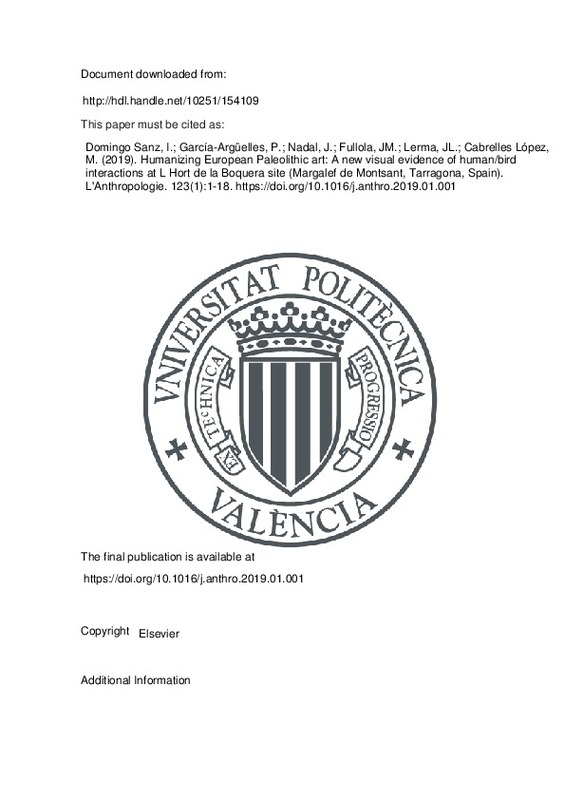Domingo Sanz, I.; García-Argüelles, P.; Nadal, J.; Fullola, JM.; Lerma, JL.; Cabrelles López, M. (2019). Humanizing European Paleolithic art: A new visual evidence of human/bird interactions at L Hort de la Boquera site (Margalef de Montsant, Tarragona, Spain). L'Anthropologie. 123(1):1-18. https://doi.org/10.1016/j.anthro.2019.01.001
Por favor, use este identificador para citar o enlazar este ítem: http://hdl.handle.net/10251/154109
|
Título:
|
Humanizing European Paleolithic art: A new visual evidence of human/bird interactions at L Hort de la Boquera site (Margalef de Montsant, Tarragona, Spain)
|
|
Otro titulo:
|
Humanisation dans l art paléolithique européen : nouvelles preuves visuelles des interactions hommes/oiseaux à L Hort de la Boquera (Margalef, Tarragone, Espagne)
|
|
Autor:
|
Domingo Sanz, Inés
García-Argüelles, Pilar
 Nadal, Jordi
Fullola, Josep M.
Nadal, Jordi
Fullola, Josep M.

 Lerma, José Luis
Cabrelles López, Miriam
Lerma, José Luis
Cabrelles López, Miriam
|
|
Entidad UPV:
|
Universitat Politècnica de València. Departamento de Ingeniería Cartográfica Geodesia y Fotogrametría - Departament d'Enginyeria Cartogràfica, Geodèsia i Fotogrametria
|
|
Fecha difusión:
|
|
|
Resumen:
|
[EN] This paper reports the discovery of a new example of portable art in North-eastern Iberia dating to the Late Upper Palaeolithic (12.250 60 BP). The piece is analysed in relation to the European Palaeolithic art ...[+]
[EN] This paper reports the discovery of a new example of portable art in North-eastern Iberia dating to the Late Upper Palaeolithic (12.250 60 BP). The piece is analysed in relation to the European Palaeolithic art assemblage to determine its significance and how it contributes to our understandings of Palaeolithic artistic practices. Both the motifs depicted (birds and humans) and the patterns of composition (a narrative scene) are unusual in Palaeolithic assemblages. In addition, this new find contributes to filling a geographic gap in the artistic record as evidence of Palaeolithic art is rare in Catalonia. The anatomical features of one of the birds suggest that it is a crane, a species that has been depicted in a limited number of sites, as summarized in this paper. Moreover, there are only three known example of birds and humans interacting in a narrative scene in Palaeolithic art. Exhibiting innovations in media, subject matter and compositional norms, this new find has the potential to change the classic definition of European Upper Palaeolithic art and integrate the region in the artistic trends circulating along Mediterranean Iberia during the Upper Magdalenian. (C) 2019 Elsevier Masson SAS. All rights reserved.
[-]
[Otros] Cette étude présente la découverte d¿un nouvel exemple d'art mobilier dans le nord-est de la Péninsule Ibérique qui remonte au Paléolithique supérieur final (12,250 ± 60 BP). La pièce est examinée dans le contexte ...[+]
[Otros] Cette étude présente la découverte d¿un nouvel exemple d'art mobilier dans le nord-est de la Péninsule Ibérique qui remonte au Paléolithique supérieur final (12,250 ± 60 BP). La pièce est examinée dans le contexte de l¿art paléolithique européen pour déterminer son importance et sa contribution à notre compréhension des pratiques artistiques paléolithiques. Les motifs représentés (oiseaux et humains) et les schémas de composition (une scène narrative) sont, dans les deux cas, rares dans les ensembles paléolithiques. En outre, cette nouvelle découverte contribue à combler un vide géographique dans le registre artistique car les évidences matérielles de l'art paléolithique sont rares en Catalogne. Les caractéristiques anatomiques d¿un des oiseaux suggèrent qu'il s¿agit d¿une grue, une espèce qui a été représentée dans un nombre limité de sites, comme cet article le synthétise. En outre, il n¿y a que trois exemples connus d¿oiseaux et d¿humains en interaction dans une scène narrative dans l¿art paléolithique. Exposant des innovations dans le support graphique, les thématiques et les normes de composition, cette nouvelle découverte a le potentiel de changer la définition classique de l¿art paléolithique européen et d¿intégrer la région dans les tendances artistiques circulant en Ibérie méditerranéenne pendant le Magdalénien Supérieur. @2019 Elsevier Masson SAS. Tous droits réservés.
[-]
|
|
Palabras clave:
|
Palaeolithic art
,
Portable art
,
Late Upper Magdalenian
,
Crane
,
Anthropomorphic figures
,
Scenes
,
Art Paléolithique
,
Art mobilier
,
Magdalénien supérieur final
,
Grue
,
Figures anthropomorphes
,
Scènes
|
|
Derechos de uso:
|
Reserva de todos los derechos
|
|
Fuente:
|
L'Anthropologie. (issn:
0003-5521
)
|
|
DOI:
|
10.1016/j.anthro.2019.01.001
|
|
Editorial:
|
Elsevier
|
|
Versión del editor:
|
https://doi.org/10.1016/j.anthro.2019.01.001
|
|
Código del Proyecto:
|
info:eu-repo/grantAgreement/Generalitat de Catalunya//CL T009%2F18%2F00001/
info:eu-repo/grantAgreement/AEI/Plan Estatal de Investigación Científica y Técnica y de Innovación 2013-2016/HAR2017-86509-P/ES/LAS SOCIEDADES HUMANAS Y SU INTERACCION CON EL ENTORNO EN EL NE PENINSULAR DESDE EL PLEISTOCENO SUPERIOR HASTA INICIOS DEL HOLOCENO/
info:eu-repo/grantAgreement/MINECO//HAR2016-80693-P/ES/REDEFINIENDO EL ARTE LEVATINO DESDE LA INTERDISCIPLINARIDAD: ARQUEOLOGIA, CIENCIAS DEL PATRIMONIO Y TECNOLOGIAS DIGITALES AL SERVICIO DEL CONOCIMIENTO Y LA CONSERVACION/
info:eu-repo/grantAgreement/Generalitat de Catalunya//2017 SGR 11/
|
|
Agradecimientos:
|
The authors would like to thank several researchers for their contribution at different stages of this paper preparation. To E. Brieva for her significant contribution in the field. We also thank our colleagues V. Villaverde ...[+]
The authors would like to thank several researchers for their contribution at different stages of this paper preparation. To E. Brieva for her significant contribution in the field. We also thank our colleagues V. Villaverde for his suggestions regarding the potential interpretation of the motifs, and G. Bosinski, J. Zilhão, F. D Errico and M. García-Diez for providing references and/or publications of interest to this work. Finally, we thank C. Smith for her suggestions regarding content and English translation, and M. Teixidó for her comments on the French abstract.
The authors acknowledge the support of several funding programs and projects: Fieldwork funds granted to P. García-Argüelles and J. Nadal by Generalitat de Catalunya (CL T009/18/00001). Projects HAR2017-86509-P granted to J.M. Fullola and P. García-Argüelles and HAR-2016-80693-P granted to I. Domingo by the Spanish Ministry of Economy, Industry and Competitiveness; and the Quality Research Group 2017SGR-11, granted to J.M. Fullola by Generalitat de Catalunya.
[-]
|
|
Tipo:
|
Artículo
|







![[Cerrado]](/themes/UPV/images/candado.png)


